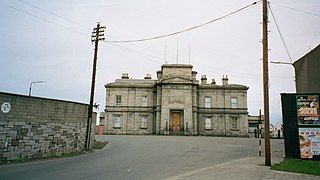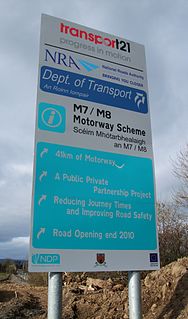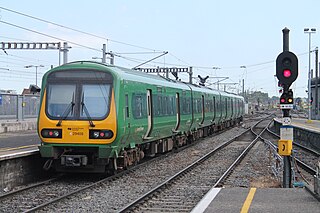This article needs additional citations for verification .(November 2013) (Learn how and when to remove this template message) |


Amiens Street, located in Dublin, Ireland was named after Viscount Amiens, Earl of Aldborough. It is one of the most frequented streets by railway passengers using Dublin Connolly station which was formerly called Amiens Street Station opened in 1844. It was renamed after James Connolly. The Italianate architecture of the Dublin and Drogheda Railway station buildings are the focal point of the street. The street was one of the boundaries of Dublin's red-light district, Monto, [1] that existed between the 1860s - 1920s.

Dublin is the capital of, and largest city in, Ireland. It is on the east coast of Ireland, in the province of Leinster, at the mouth of the River Liffey, and is bordered on the south by the Wicklow mountains. It has an urban area population of 1,173,179, while the population of the Dublin Region, as of 2016, was 1,347,359, and the population of the Greater Dublin area was 1,904,806.

Ireland, also known as the Republic of Ireland, is a country in north-western Europe occupying 26 of 32 counties of the island of Ireland. The capital and largest city is Dublin, which is located on the eastern part of the island, and whose metropolitan area is home to around a third of the country's over 4.8 million inhabitants. The sovereign state shares its only land border with Northern Ireland, a part of the United Kingdom. It is otherwise surrounded by the Atlantic Ocean, with the Celtic Sea to the south, Saint George's Channel to the south-east, and the Irish Sea to the east. It is a unitary, parliamentary republic. The legislature, the Oireachtas, consists of a lower house, Dáil Éireann, an upper house, Seanad Éireann, and an elected President who serves as the largely ceremonial head of state, but with some important powers and duties. The head of government is the Taoiseach, who is elected by the Dáil and appointed by the President; the Taoiseach in turn appoints other government ministers.
Earl of Aldborough, of the Palatinate of Upper Ormond, was a title in the Peerage of Ireland held by the Noble House of Stratford. It was created on 9 February 1777, along with the courtesy title of Viscount Amiens, for John Stratford, 1st Viscount Aldborough, a descendant of the English Stratford family. He had already been created Baron Baltinglass, of Baltinglass, in the County of Wicklow, on 21 May 1763, and Viscount Aldborough, of the Palatinate of Upper Ormond, on 22 July 1776. These titles were also in the Peerage of Ireland. Three of his sons, the second, third and fourth Earls, all succeeded in the titles. They became extinct on the death of the latter's grandson, the sixth Earl, in 1875.
Contents
The street links the International Financial Services Centre and the Custom House Quay across the tramlines of the LUAS where there is street level tram terminal and interchange for the trains in Dublin Connolly. Across the road over the pedestrian crossing is Talbot Street. Further up the street with an over bridge carrying the DART (en route to Tara Street across the Liffey) over the street to the North Strand Road heading towards Fairview.

The International Financial Services Centre began in 1987 as a special economic zone on a derelict 11 hectare site near the centre of Dublin, with EU approval to apply a 10% corporate tax rate for designated financial services activities on the site. Before the expiry of this EU approval in 2005, the Irish Government legislated in 1998/99 to effectively "turn the entire country into an IFSC" by reducing the overall Irish corporate tax rate from 32% to 12.5%. The legal requirement for a specific IFSC geographic area was thus removed, and the term International Financial Services ("IFS") sector is now sometimes used.

The Custom House is a neoclassical 18th century building in Dublin, Ireland which houses the Department of Housing, Planning and Local Government. It is located on the north bank of the River Liffey, on Custom House Quay between Butt Bridge and Talbot Memorial Bridge.

A pedestrian crossing or crosswalk is a place designated for pedestrians to cross a road, street, blvd and ave. Pelican crosswalks are designed to keep pedestrians together where they can be seen by motorists, and where they can cross most safely across the flow of vehicular traffic.
The 19th century Irish novelist, Charles Lever, was born in No. 35 Amiens Street.

Charles James Lever was an Irish novelist and raconteur, whose novels, according to Anthony Trollope, were just like his conversation.


















